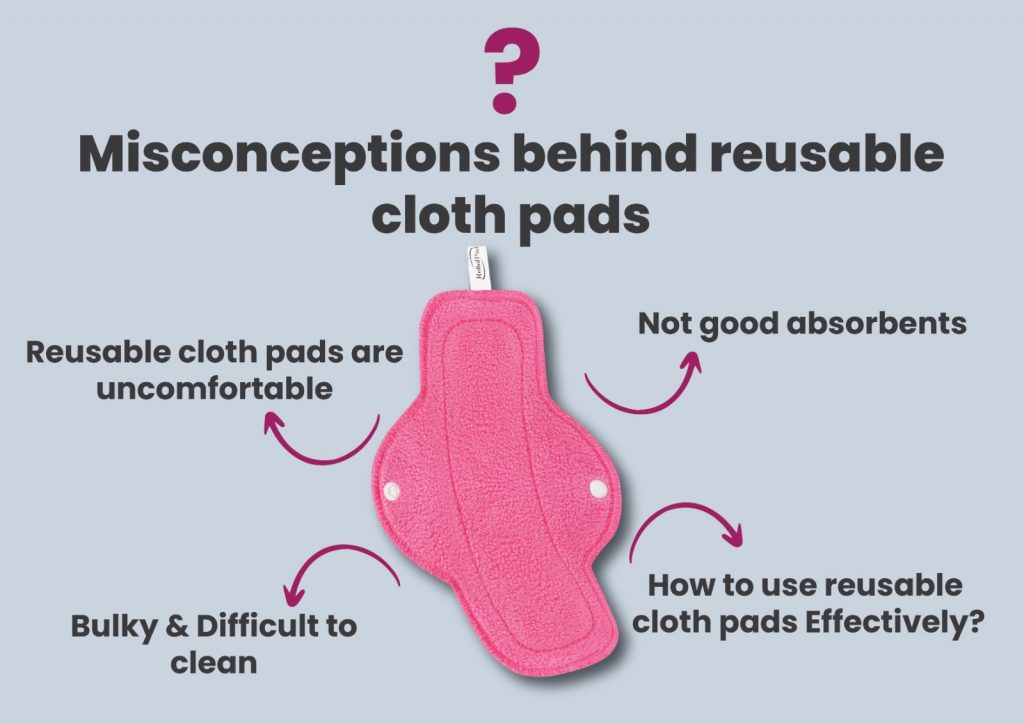Reusable Sanitary pads for the Environment:

Reusable cloth pads have gained popularity in recent years as an eco-friendly and cost-effective alternative to disposable menstrual products. However, there are still many misconceptions surrounding their use.
In this article, we aim to debunk those myths and provide you with essential information about reusable cloth pads also exploring the do’s and don’ts to ensure a comfortable and hygienic experience. By the end, you’ll have a comprehensive understanding of these sustainable menstrual products, empowering you to make an informed choice for your period care needs.
Misconceptions about Reusable Cloth Pads
Misconception: Cloth pads are bulky and uncomfortable
Reality: Reusable cloth pads come in various sizes and shapes, providing options for different flow levels. They are designed to be comfortable, lightweight, and discreet, offering a snug fit that stays in place. Modern fabric technologies and innovative designs ensure breathability, preventing discomfort and irritation.
Misconception: Cloth pads are difficult to clean
Reality: Cleaning cloth pads is easier than it may seem. Most cloth pads have a removable absorbent insert that can be washed separately. Soaking the used pads in cold water before washing can help minimize staining. Machine wash them with a gentle detergent and avoid using fabric softeners, as they can reduce absorbency. Proper care and maintenance will keep your cloth pads hygienic and long-lasting.
Misconception: Cloth pads are not absorbent enough
Reality: Reusable cloth pads are made from highly absorbent materials like organic cotton, bamboo, or microfiber. They often come with multiple layers to enhance absorption capacity. By choosing the right thickness and size for your flow, cloth pads can provide reliable protection, equivalent to or even surpassing disposable pads.
Do’s for Using Reusable Cloth Pads
- Do choose the right size and absorbency level: Select cloth pads based on your flow and personal preferences. Consider factors like thickness, length, and width to find the most comfortable fit for you.
- Do pre-wash your cloth pads before first use: Washing new cloth pads helps improve their absorbency. Follow the manufacturer’s instructions for pre-washing to ensure optimal performance.
- Do rinse or soak used pads: Rinse or soak cloth pads in cold water after use to minimize staining. This step helps remove excess blood before washing them.
- Do use a mild detergent: Opt for a gentle, fragrance-free detergent when washing cloth pads. Harsh chemicals and additives can irritate the skin or affect absorbency.
Don’ts for Using Reusable Cloth Pads
- Don’t use bleach or harsh chemicals: Avoid using bleach or harsh chemicals to clean cloth pads, as they can deteriorate the fabric and compromise absorbency. Stick to natural and mild cleaning agents.
- Don’t leave used pads unwashed for too long: To prevent stains from setting, avoid leaving used cloth pads unwashed for an extended period. If you can’t wash them immediately, soak them in cold water until you can.
- Don’t use fabric softeners or dryer sheets: Fabric softeners and dryer sheets can leave residue on cloth pads, reducing their absorb.
ReliefPad Recommends Using its Best Reusable Cloth Pads for Periods
At ReliefPad, we are proud to offer a range of high-quality reusable cloth pads for menstrual care. Our reusable cloth pads are designed with comfort, sustainability, and your well-being in mind. We understand that every woman’s period is unique, which is why we have developed a versatile collection to suit different flow levels and preferences.
Choose ReliefPad for sustainable, reliable, and comfortable period care. Experience the freedom and confidence that comes with using our reusable cloth pads. Together, let’s create a world where periods are embraced, and the environment is protected.

